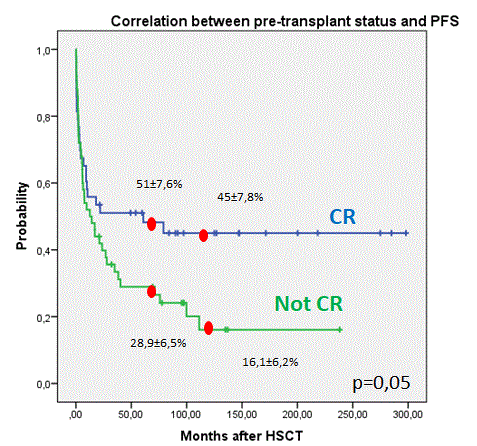
Contributions
Abstract: PB1788
Type: Publication Only
Session title: Stem cell transplantation - Clinical
Background
Performing a 2nd Hematopoietic Stem Cell Transplantation (HSCT) after the relapse of the underlying disease is one of the therapeutic strategies in patients who achieve a response after relapse.
Aims
The aim of our study is to analyze the results and prognostic factors in patients who underwent a 2nd allogeneic HSCT.
Methods
We studied 126 patients who received a 2nd allogeneic HSCT in our center between 1995-2019, the 1st HSCT being autologous or allogeneic. Two groups were established: 1st: 1st autologous-2nd allogeneic / 2nd: 1st allogeneic-2nd allogeneic. Patient’s characteristics are shown in Table1.
Results
With a median follow-up of 96 months (range: 21-300), the probabilities of overall survival (OS), progression-free survival (PFS), and probability of relapse (RP) at 5 and 10 years are 44.5 ± 5% (5 years); 31±5% (10 years), 38.9± 5% (5 years); 29.2± 5% (10 years) and 38 ± 6% (5 years); 46.2±7% (10 years) in the 1st group and 35.1±9% (5 years); 30±9% (10 years), 38.9± 9% (5 and 10 years) and 53.7±10% (5 and 10 years) in the 2nd group, respectively.
Transplant-related mortality in the first 100 days (TRM100) and global TRM are 23.4% and 39.4% in the 1st group and 12.5% and 18.8% in the 2nd group, respectively. There are no differences in the TRM100 or global TRM according to the intensity of the 2nd HSCT conditioning.
PFS is higher in patients transplanted in complete response: 43±7% vs 23.5±6% (p= 0.17). This advantage in PFS reached statistical significance in the 1st group: 45 ± 7.8% vs 16 ± 6%, p = 0.05. (Figure 1)
The presence of acute GVHD did not influence significantly OS, PFS or PR in any of the groups. The presence of chronic GVHD decreases PR and increases PFS and OS, but without being statistically significant.
We did not observe differences in OS, PFS or PR depending on whether the same or different donor was used in the 2nd HSTC, or whether the relapse was early or late.

Conclusion
Carrying out a 2nd HSCT in patients who relapse after a 1st HSCT is a feasible treatment option that offers a survival of 53 ± 4.4% at 5 years and 34.6 ± 4.6% at 10 years, being the main influencing factor the disease status at the 2nd HSCT.
Keyword(s): Second transplant, Stem cell transplant
Abstract: PB1788
Type: Publication Only
Session title: Stem cell transplantation - Clinical
Background
Performing a 2nd Hematopoietic Stem Cell Transplantation (HSCT) after the relapse of the underlying disease is one of the therapeutic strategies in patients who achieve a response after relapse.
Aims
The aim of our study is to analyze the results and prognostic factors in patients who underwent a 2nd allogeneic HSCT.
Methods
We studied 126 patients who received a 2nd allogeneic HSCT in our center between 1995-2019, the 1st HSCT being autologous or allogeneic. Two groups were established: 1st: 1st autologous-2nd allogeneic / 2nd: 1st allogeneic-2nd allogeneic. Patient’s characteristics are shown in Table1.
Results
With a median follow-up of 96 months (range: 21-300), the probabilities of overall survival (OS), progression-free survival (PFS), and probability of relapse (RP) at 5 and 10 years are 44.5 ± 5% (5 years); 31±5% (10 years), 38.9± 5% (5 years); 29.2± 5% (10 years) and 38 ± 6% (5 years); 46.2±7% (10 years) in the 1st group and 35.1±9% (5 years); 30±9% (10 years), 38.9± 9% (5 and 10 years) and 53.7±10% (5 and 10 years) in the 2nd group, respectively.
Transplant-related mortality in the first 100 days (TRM100) and global TRM are 23.4% and 39.4% in the 1st group and 12.5% and 18.8% in the 2nd group, respectively. There are no differences in the TRM100 or global TRM according to the intensity of the 2nd HSCT conditioning.
PFS is higher in patients transplanted in complete response: 43±7% vs 23.5±6% (p= 0.17). This advantage in PFS reached statistical significance in the 1st group: 45 ± 7.8% vs 16 ± 6%, p = 0.05. (Figure 1)
The presence of acute GVHD did not influence significantly OS, PFS or PR in any of the groups. The presence of chronic GVHD decreases PR and increases PFS and OS, but without being statistically significant.
We did not observe differences in OS, PFS or PR depending on whether the same or different donor was used in the 2nd HSTC, or whether the relapse was early or late.

Conclusion
Carrying out a 2nd HSCT in patients who relapse after a 1st HSCT is a feasible treatment option that offers a survival of 53 ± 4.4% at 5 years and 34.6 ± 4.6% at 10 years, being the main influencing factor the disease status at the 2nd HSCT.
Keyword(s): Second transplant, Stem cell transplant


